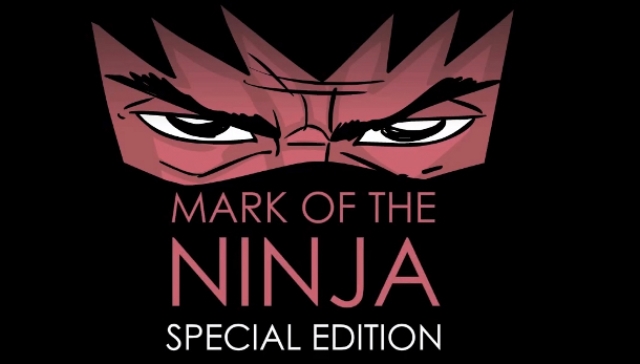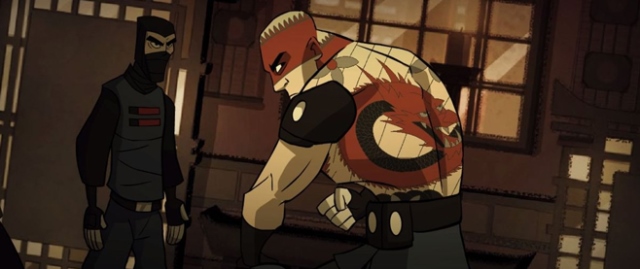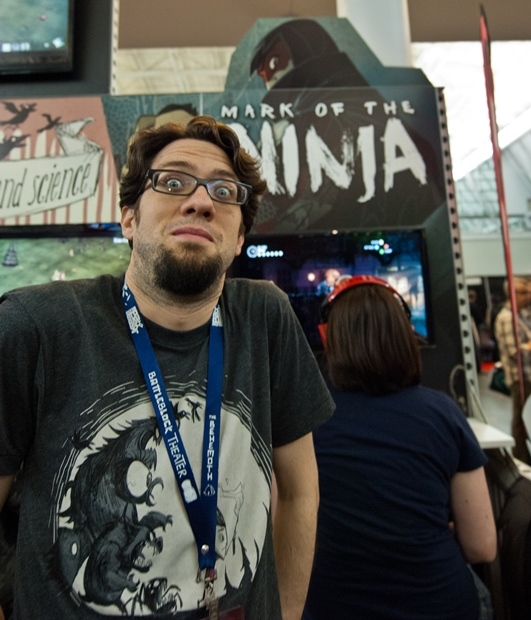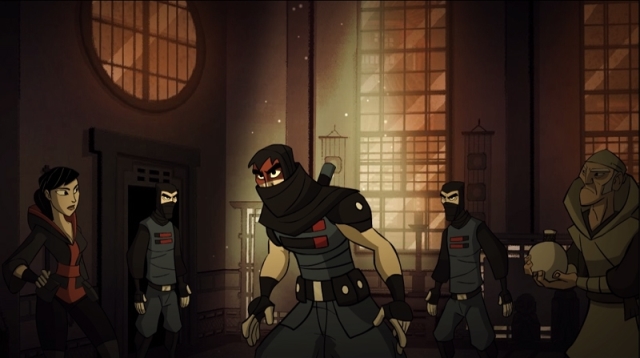Mark of the Ninja Special Edition preview: A (mostly) harmless punch in the dark
“So, you guys wanna…play my game?” Mark of the Ninja Lead Designer Nels Anderson asks in a playful voice, his brow raising inquisitively and his hips swinging side to side in rhythm with the last three words of his question. It makes for a silly little dance that the XBLAFans crew gathered around him can’t help but laugh at. We’re about to play a stealth game tucked inside the walls of the Indie Megabooth here at PAX East, but Anderson, with his improv dance move, doesn’t exactly come off as sly.
No, Anderson can’t or won’t bring himself to be sneaky about Mark of the Ninja: Special Edition. His excitement over having us play his latest creation is such that he’s not going to follow in the silent footsteps of the game’s titular ninja. So he doesn’t lurk back in Klei’s personal Indie Megabooth crevice; he’s energetic, and it’s not long before he puts a controller in my hands. Now our attention turns to the screen where all of the requisite sneaking will be performed.
Whereas its contemporaries have tended to make the ninja into an action hero who’s so far over the top that he’d likely make the cast of The Expendables blush, Mark of the Ninja has always emphasized the ninja as a virtually unseen agent of death and/or stealthy sabotage. Whether approaching levels as a killer who isn’t detected until its too late or an infiltrator who isn’t detected at all, players had to stick to the shadows and remain as invisible as possible in order to achieve any kind of measure of success. It was a great system, but one that meant enemies presented but two choices: players could kill them or avoid them. Mark of the Ninja: Special Edition adds another option to the mix.
The mark of the ninja is black and blue
Slinking unseen out of the shadows behind the first enemy in the demo, I hit the attack button and get ready to enjoy the satisfying throat-slitting animation familiar to anyone who’s played the game before. The animation doesn’t start. Instead, the bad guy drops to the ground. He’s down and out, but he’s alive. There is no killing in what essentially amounts to a director’s cut of Klei Entertainment’s stealth-action title.
“One of the things we added to the Special Edition is a new playstyle based on the tattoo art,” Anderson explains. “So this is a new level, and the heart of it is…it’s framed like a flashback. His main ability is non-lethal takedowns.
“This character doesn’t have [the assassination ability]. He’s only non-lethal takedowns. So, like, if you remember the main game there was one of the styles that was totally non-lethal. He didn’t have the sword — it was like the ultimate stealth mode — and then, obviously, all of the other ones did. And so the point of this one was to kind of split the difference to give you a little bit of offensive ability, but you can still do the non-lethal run where you get the no-enemies-killed bonus, and all that good stuff.”
Anderson goes on to say only “a few people” requested a non-lethal takedown. He doesn’t have any regrets about not including it in the original release, and the reportedly low number of gamers who asked for it would seem to validate his belief that leaving it out was the right decision. Its omission meant more players ended up approaching Mark of the Ninja‘s levels with complete covertness than otherwise would have. If they wanted to avoid killing, they had to buy into a wholesale abstinence from violence. There was no other choice, no knocking enemies out cold in last-second move of desperation to avoid detection. So why the change of heart for the Special Edition? Why not leave well enough alone?
Anderson says it’s a matter of timing. “It actually is a very different way to play the game when you don’t have any offensive abilities — at all.” He slowly draws out those last two words as his eyes widen. Anderson isn’t subtle. He’s made a great ninja game, but he hardly the plays the role of ninja himself. That role is reserved for Mark of the Ninja players, and soon will be the time in which they get another ninja option. “The way you have to approach the game [without offensive abilities] is completely different, and I think that’s kind of good, but now that the game is out, having a mode that’s kind of more middle-of-the-road, I think [now] is a good time to do it.”
Knocking enemies out is effective when there are only one or two nearby and the lights are out, but it’s not always the ideal way to approach more challenging enemy encounters. Players will have more than just the ninja’s brawn to rely on when they find themselves in stickier situations. Two new items will be available in the DLC. We don’t get to try out either of them in the demo, but Anderson tells us how one of them will allow players to obscure the ninja’s greatest foe: light. “There’s this big cloud of dust and bugs and ****, and the lights go out,” he says of the item, “but it doesn’t make any noise. So, again, kind of catering towards the non-lethal, stealthy playstyle there.”
How to lose a ninja in 10 comments
It’s common for special editions of video games to get new weapons, new levels and new characters, but Klei isn’t sticking strictly to game staples with its upcoming DLC; it’s also looking to a popular DVD trope. Anderson, carrying no shortage of disgust in his voice, rants briefly about how not all special edition DVD releases need a particular feature, but he thinks more games do need it. “I don’t think Marley and Me or, whatever, some god damn Matthew McConaughey romantic comedy, really needs director’s commentary — but it’s there!” he exclaims. “So I thought, ‘Why don’t we do that?'”
Anderson and the Mark of the Ninja team have gone through the entire game and added in between “like eight and 15″ developer comments to each of the game’s levels in the form of text bubbles. We don’t see it during our hands-on session, but Anderson is excited to tell us about how the team “went back to the main game and added a bunch, a bunch — and I mean a bunch! — of developer commentary. It’s not a thing that a lot of studios do, but whenever they do it’s awesome, and I wish there was more of it.”
It sounds like an interesting feature, but I can’t help but think about how much more interesting it would be if the commentary was spoken, not written. Anderson explains that it would have been an immense amount of work to do so “because it would have taken our audio guy like six months total to do it, so we didn’t do voice. It’s just text. Valve is the only studio that has done full voice recordings, that I know of, because they have an infinite well of money and time. And we have neither of those things!”
Valve has enough money and good faith from its legions of fans to do pretty much whatever it wants on its own timetable. Klei is a small studio that’s said to employ around 30 individuals. It hardly has the resources to record full audio commentary. Still, Valve isn’t the only developer to put out a special edition with voice-acted developer commentary. Just shy of three years before it stopped making games, LucasArts did so in Mystery Science Theater 3000-inspired fashion. Remedy Entertainment also recorded developer commentary for one of its games: Alan Wake. Nevertheless, it’s difficult to remember too many games that have included the feature.
The commentary in Mark of the Ninja: Special Edition comes “mostly from everybody on the team,” says Anderson. Among other things, it’ll teach curious players about the game’s art style and how the levels were made.
Nineteen little steps
The demo takes place in a new level with a subterranean setting. It’s full of traps, bad guys, pesky artificial lights and convenient crevices in which ninjas can hide from said lights, traps and bad guys. Those elements are exactly what gamers would expect to find in a Mark of the Ninja level. In one way it does stand out, though: it’s huge. Mark of the Ninja‘s levels were never really what could be accurately referred to as small, but this new level is especially large, according to Anderson. I don’t get to experience it in its entirety, but control is taken away from me at the end of the section being demoed, and the camera pans ahead showing that the level stretches well beyond what’s being shown today.
“I didn’t really mean for it to be [so big],” Anderson reveals, “but I kind of got indulgent where I’m just like, ‘Well, we can put this there, put that there, and put that there, and…oh god, this level’s gigantic now!'” His voice raises to a sort of comically high pitch as he speaks of the level suddenly contracting elephantiasis. Anderson’s voice and facial expression tell the story of a man overwhelmed by the sheer volume of options he found to be available in his own creation.
Anderson continues emphasizing the level’s enormity and says that making it, and all levels for that matter, is “extremely time-consuming.” Klei plans to release the Special Edition this summer, which is a feat it would never be able to pull off were it to add more new levels. It’s not the first time an XBLA developer has pointed out how much of a time-suck creating new DLC levels is. Ronimo Games made similar comments last year around the time Awesomenauts was released, citing that as the reason why it was unlikely to release more maps through DLC, though the Dutch developer did release a new map on Steam earlier this month.
Those interested in learning more about why they can’t get more levels in a reasonable timeframe will be able to read all about it this summer. “Actually, so, the commentary for [the new] level is the 19 step-by-step process that is required to make a level,” says Anderson. “And like one of the ‘steps’ is like, ‘Build all of the encounters!’ and it itself takes months, because everything is so sensitive to — it has to be really exact and specific, right? One dude over here and over here? It means this encounter is impossible and you die every time. But if you move him over here? Oh, now it’s challenging and interesting!”
Anderson sounds both sarcastic and proud. He’s roasting his new level and the rigid process he followed to create it while simultaneously boasting of its accomplishments. His system is necessary for making scenarios that players will enjoy, but he’s also acutely aware that its effectiveness is equaled by its ridiculousness.
Ninjas can wait forever — gamers can’t
His comment reminds me of a chat the two of us had in Seattle during last year’s PAX Prime. Anderson told me then that designing a 2D stealth system for Mark of the Ninja required a similarly imposing amount of time that was also brought on by the need for trial and error. I bring up the conversation. He’s not sure how Klei made the system and the game’s original levels come together. Rhetorically, he asks: “How the hell did we ever do this to begin with?”
He remembers that the process, like that of creating the upcoming DLC, took time. “Yeah, it’s forever.”
Klei, unlike Valve, doesn’t have forever. In a few months Mark of the Ninja: Special Edition will release, and it’ll do so with one new level.
Photography by Zac “Scratch” Pratt





